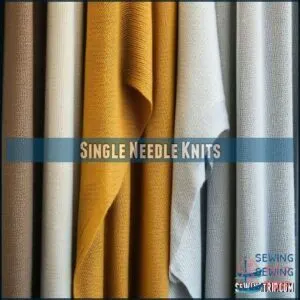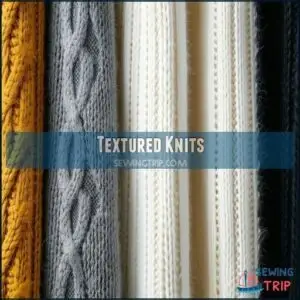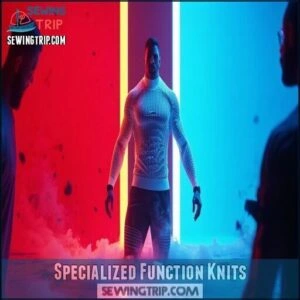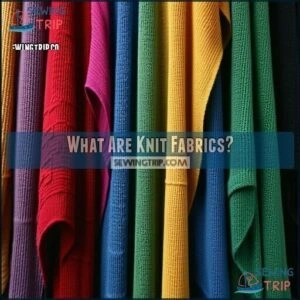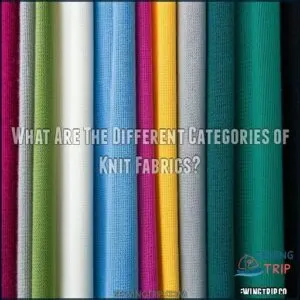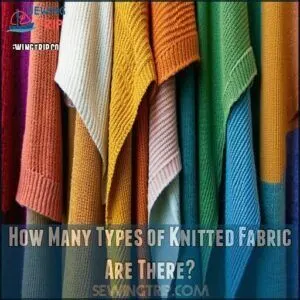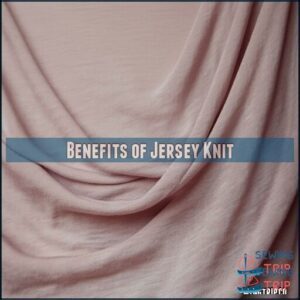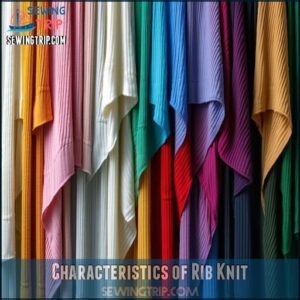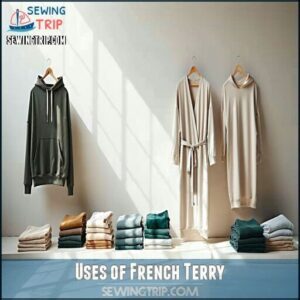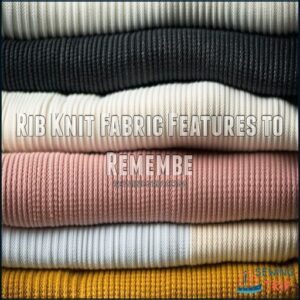This site is supported by our readers. We may earn a commission, at no cost to you, if you purchase through links.
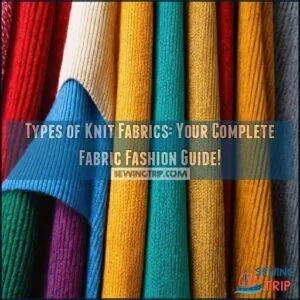 Knit fabrics come in many types, each serving a purpose.
Knit fabrics come in many types, each serving a purpose.
Jersey is your go-to for soft, stretchy T-shirts, while rib knit hugs your body, making it perfect for waistbands or cuffs.
French terry feels cozy yet breathable, ideal for hoodies.
If you’re after texture, waffle knits add warmth without bulk, and for durability, interlock knit offers a smooth, double-sided finish.
Some, like ponte, balance stretch and structure for polished outfits.
Every knit type balances stretch, comfort, and style differently, so you’ve got options for any project. Want a fabric with flair or function? There’s a knit for that. Stay curious!
Table Of Contents
- Key Takeaways
- Single Needle Knits
- Textured Knits
- Specialized Function Knits
- What Are Knit Fabrics?
- What Are The Different Categories of Knit Fabrics?
- How Many Types of Knitted Fabric Are There?
- Knitted Machine – Animation
- Jersey Knit Fabric Features to Remember
- Rib Knit Fabric Features to Remembe
- Frequently Asked Questions (FAQs)
- Conclusion
Key Takeaways
- You’ll find knit fabrics ranging from stretchy jersey to durable rib and cozy French terry, each serving unique purposes for comfort and style.
- Knit fabrics are made with looping techniques, giving them natural stretch, breathability, and softness that is perfect for everyday wear.
- Rib knit adds stretch and structure, making it ideal for cuffs and body-hugging designs, while double knits like ponte are great for polished looks.
- Understanding knit types like weft and warp knits helps you pick fabrics for specific needs, from casual wear to performance clothing.
Single Needle Knits
One type of knit fabric stands out for its simplicity: single needle knits.
These fabrics, crafted through jersey stitch formation, offer remarkable versatility in needle construction.
Remarkably versatile, jersey stitch fabrics bring effortless comfort and style to life with their lightweight charm and natural stretch.
When you explore single jersey fabric, you’ll discover a lightweight material that breathes and moves with incredible ease.
The unique characteristic of these knits lies in their distinctive right and wrong sides, with edges that naturally curl when stretched.
Manufacturers create single knit fabrics using various fibers like cotton, polyester, and bamboo, ensuring diverse applications from casual wear to performance clothing.
Understanding the fabric properties helps you choose the perfect jersey knit for your next project, whether you’re designing comfortable loungewear or stylish everyday apparel.
Textured Knits
Venture into textured knit fabrics, where fashion meets function through intricate weaving techniques.
These fabric marvels transform ordinary garments into style statements:
- Texture Magic: Rib and interlock knits create eye-catching vertical lines and double-faced surfaces.
- Fabric Flexibility: Stretch meets structure with unique knitting methods.
- Design Diversity: From turtlenecks to home furnishings, textured knits offer endless creativity.
- Structural Brilliance: Each weave tells a story of craftsmanship and innovation.
Cable knit and velour patterns breathe life into sweaters, while purl knit warmth embraces your silhouette with cozy sophistication.
Specialized Function Knits
Ready to level up your fabric knowledge?
Specialized function knits are the superheroes of textile technology, engineered for performance across multiple industries. These smart fabrics transform ordinary materials into extraordinary solutions:
- Medical textiles provide precision compression for health management
- Performance knitwear delivers ultimate athletic performance
- Protective clothing integrates cutting-edge moisture-wicking capabilities
From sports gear to healthcare applications, these innovative stretch knit fabrics aren’t just clothing—they’re engineered solutions.
Manufacturers are pushing boundaries by incorporating sustainable materials and advanced knitting techniques, creating versatile textiles that adapt to your body’s unique needs.
What Are Knit Fabrics?
Threads intertwined like a cozy puzzle – that’s the heart of knit fabrics.
Knit fabrics: where simple yarns twist into comfort, stretch, and style, hugging your body in effortless elegance.
These magical materials transform simple yarns into stretchy, comfortable textiles that hug your body just right. Knit construction is all about creating flexible fabrics through ingenious looping techniques that set them apart from traditional woven materials.
- Fiber Variety: From cotton to silk, knit fabrics embrace diverse yarn types
- Comfort Factors: Exceptional stretch and softness make these fabrics wardrobe champions
- Manufacturing Methods: Intricate looping processes create unique fabric textures
Warp and weft knitting techniques bring these fabrics to life, with each method offering distinct characteristics.
Whether you’re crafting a sleek jersey dress or a cozy sweater, understanding knit fabric types opens up a world of textile possibilities that blend comfort, style, and technical innovation.
What Are The Different Categories of Knit Fabrics?
With knit fabrics, understanding their categories is like traversing a textile treasure map.
The primary classification revolves around fabric construction methods: weft and warp knitting techniques, each offering unique stretch percentage and comfort factors.
Weft knits, running horizontally, provide exceptional elasticity in jersey, rib, and interlock styles—perfect for casual wear that moves with you.
Warp knits, characterized by vertical yarns, deliver superior dimensional stability and resistance to fraying, ideal for more structured garments.
Durability aspects differ between these categories, with weft knits offering more stretch and warp knits providing crisp, defined shapes.
For example, polyester offers durability, making it ideal for outdoor use.
By recognizing these fundamental fabric types, you’ll master knit fabric identification, selecting the perfect material for every project’s specific needs.
Your clothing choices will never be the same!
How Many Types of Knitted Fabric Are There?
Whether you’re a fashion enthusiast or textile novice, understanding knit fabric types can revolutionize your wardrobe choices.
Knit fabrics offer a fascinating world of textile diversity, each with unique characteristics that impact comfort and style.
- Knit Fabric Variety ranges from stretchy jerseys to structured double knits
- Manufacturing Method Effects determine fabric performance and texture
- Fiber Material Influence creates distinct properties like breathability and durability
- Stretch Percentage Impact affects garment fit and movement
- Application-Specific Knits solve design challenges across industries
Your fabric selection matters more than you might think.
Different knitting techniques transform basic yarns into sophisticated textiles, with production methods like weft and warp knitting creating everything from athletic wear to elegant dresses.
Considering fabric weight and GSM is essential for selecting the right material for your project.
Understanding these nuances empowers you to make informed textile choices that elevate your personal style.
Knitted Machine – Animation
Imagine this: a symphony of yarns performing under the expert finesse of knitting machines.
These marvels of technology use animation fidelity and machine precision to bring fabric to life. Through detailed fabric simulation, you can see the mesmerizing loop formation process, where countless threads interlock to create elastic, breathable textiles.
Machine knitting isn’t just about speed—it’s an art of automated design and flawless knitting techniques.
Knitting processes come alive as rows of loops are formed seamlessly, each stitch contributing to the fabric’s stretch, strength, and flexibility.
By visualizing these processes through animations, you’ll gain insightful knowledge about how your favorite machine-wash fabrics are crafted.
It’s like watching the backstage magic of textiles unfold, giving you a fresh appreciation for the engineering behind what we wear daily.
Jersey Knit Fabric Features to Remember
You’ll love how versatile and comfortable jersey knit fabric is, making it a staple for everyday clothing like T-shirts and dresses.
Its natural stretch, lightweight feel, and smooth drape make it both practical and stylish for a range of uses. Complete concepts and separate lines.
Benefits of Jersey Knit
Jersey knit fabric is the softest knit fabric you’ll find, offering breathable comfort and excellent fabric drape for various clothing items.
Its stretchiness keeps you moving easily, while low-maintenance care makes it hassle-free.
Cost effectiveness and versatile applications, from casual tees to flowy dresses, make certain it fits any wardrobe.
It’s like comfort on autopilot!
Characteristics of Rib Knit
Rib knit fabric is all about texture and stretch.
Its signature rib knit structure, created by alternating knit and purl stitches, gives it a flexible, durable quality.
You’ll find rib knit variations adjusted by weight, gauge, or fiber blends. Perfect for body-hugging designs, it stretches beautifully without losing shape.
Here’s why ribs stand out:
- Stretchy flexibility
- Rib stitch structure
- Comfortably durable
- Works in versatile gauges
- Diverse rib knit blends
Uses of French Terry
French Terry knit is your go-to for cozy yet versatile apparel.
It’s perfect for loungewear, athletic wear, and casual pieces like hoodie sweatshirts, joggers, and wrap dresses.
With its soft loops and lightweight terry fabric weight, it balances comfort and durability.
Available in French Terry blends, it’s a great fleece knit fabric alternative that layers well year-round.
Consider browsing options for French Terry apparel for your next project.
Rib Knit Fabric Features to Remembe
If you’re after stretch and durability, rib knit fabric is a top choice thanks to its unique elasticity.
Its textured ribbing adds both style and functionality, making it perfect for cuffs, waistbands, and everyday wear.
Stretch and Elasticity
Elasticity in rib knit fabric is a game-changer, thanks to its unique knit structure and use of elastane.
The stretch percentage allows impressive flexibility for snug fits, while fabric recovery guarantees garments maintain shape.
Stretch knit denim and other stretchy fabrics owe their comfort factor to a high elastic modulus, delivering ease of movement without sacrificing durability or style.
Textured Ribbed Appearance
Rib knits stand out for their textured appeal.
The ribbed fabric textures you’ll notice often feature vertical ribbing effects or horizontal ribbing styles, created by alternating stitches in ribbed knit patterns.
These rib stitch techniques add depth and stretch, giving rib knit fabric its signature look.
Whether it’s vertical stripes or subtle ribbed weave variations, the texture feels timeless yet modern.
When choosing fabrics, remember that GSM affects drape.
Versatile Uses and Applications
Think beyond basic clothing—rib knits are a powerhouse in knitwear fashion.
From snug cuffs to cozy sweaters, their flexibility makes designing a breeze.
Perfect for athletic performance, home textiles, and even medical applications, they’re a go-to fabric.
With stretchy comfort and stylish texture, rib knits prove versatile in fashion design, fabric applications, and creating industrially practical clothing items.
Many consumers enjoy the comfort of ribbing in their garments. Perfect for athletic performance, comfort of ribbing, designing a breeze.
Frequently Asked Questions (FAQs)
What are the different types of double knit fabrics?
Double knit fabrics, known for their thicker, stable structure, include Ponte, Interlock, and Scuba.
They’re created with two interlocked layers, giving you reversible designs, less stretch, and ideal versatility for custom clothing and professional wear.
What are the different types of knitted fabrics?
Knitted fabrics range from stretchy jersey and soft interlock to durable rib knits and intricate lace knits.
You’ll find options like mesh, velour, and sweater knits, each adapted for specific uses and styles.
What are knit fabrics?
Knit fabrics are created by looping fibers into stretchy, breathable patterns.
They’re naturally flexible, soft, and durable, making them a go-to for comfy, everyday wear.
Think T-shirts, leggings, or cozy sweaters packed with personality.
Which fabric is best for knitting?
The best fabric for knitting depends on your project.
Wool is versatile and stretchy, perfect for warmth.
Cotton offers breathability for lighter pieces, while acrylic’s budget-friendly durability suits beginners.
Mixes blend strengths for customized results!
What types of clothing are made from knit fabrics?
You’ll find knit fabrics in T-shirts, sweaters, leggings, dresses, and even underwear.
They’re also great for athletic wear, offering flexibility and breathability.
Their softness, stretch, and durability make them perfect for everyday, comfortable clothing.
What are the different types of knits?
Sure, fabrics that behave like yoga instructors? That’s knit for you!
From stretchy rib knits to durable double knits, lightweight mesh, or cozy cable types, explore endless variations customized for style, function, and flexibility.
Can knit fabrics be used for formal or professional attire?
You can absolutely use knit fabrics for formal attire!
Opt for double knits or ponte knits—they provide structure and polish.
These fabrics offer comfort, drape beautifully, and create custom-made looks perfect for offices or professional events. These fabrics offer comfort, drape beautifully, and create custom-made looks perfect for offices or professional events.
Are there any specific care instructions for knit fabrics?
Caring for knit fabrics is like nurturing a flexible friendship—gentle washing in cool water, avoiding high heat, and air drying preserves their stretch and softness.
Avoid wringing; it’s their kryptonite, causing distortion and wear.
What are some common applications for French Terry knit fabric?
French Terry knit fabric works great for loungewear, sweatshirts, and joggers thanks to its cozy, looped interior.
It’s also popular for lightweight hoodies, baby clothes, and stylish casualwear—soft, breathable, and perfect for relaxed comfort.
How is knit fabric different from woven fabric?
It’s funny how knit and woven fabrics form your wardrobe’s backbone but differ so much.
Knit fabrics stretch and loop like teamwork, while woven fabrics crisscross tightly, offering structure but less flexibility.
Conclusion
Much like how vinyl records made a retro comeback, choosing the right knit fabric depends on your needs.
From jersey’s soft stretch to rib knit’s structured hold or French terry’s cozy feel, each type of knit fabric serves a unique purpose.
Whether you’re crafting stylish tops, comfy hoodies, or durable wardrobe staples, understanding these options empowers your creativity.
So, explore the types of knit fabrics, experiment with textures, and bring your design ideas to life effortlessly! understanding these options

